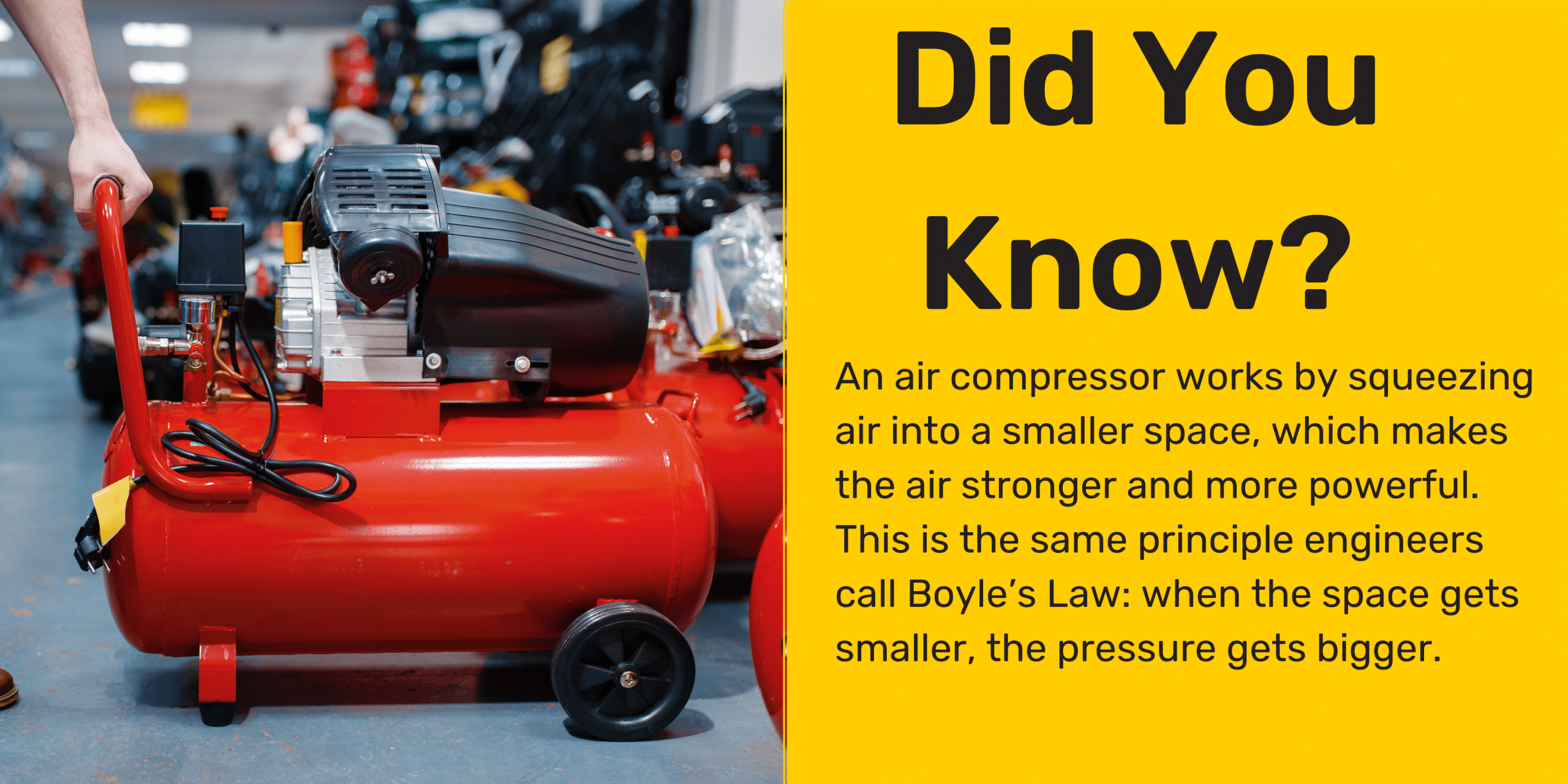Are you keen to understand how does an air compressor work?
Guess what you have landed in the right place online.
In this ToolsGaloreHQ guide, you will learn:
- How it works;
- How to keep it in tip top condition;
- Maintenance tips; and
- So Much More.

Understanding how an air compressor works is essential for anyone using pneumatic tools.
These machines convert electrical energy into kinetic energy by compressing air, creating pressurized air for various applications. However, the intricacies of their operation vary across different types, such as reciprocating and rotary screw compressors.
To maximize efficiency and longevity, one must consider maintenance and operational practices. What factors contribute to optimal performance, and how do the different mechanisms function?
Why this guide on how does an air compressor work
Understanding how an air compressor works is essential for anyone involved in projects that require compressed air, as it enables users to make informed decisions when selecting equipment.
This guide demystifies the mechanics of air compressors, illustrating their role in harnessing the power of compressed air for diverse applications.
By grasping the principles behind air compression, individuals can liberate their creativity and enhance their project efficiency. Knowledge of compressor types, components, and functions empowers users to choose the right tools tailored to their specific needs, whether for industrial tasks or personal endeavors.
Ultimately, this understanding fosters independence and confidence, allowing users to navigate their projects with clarity and purpose, transforming challenges into opportunities for innovation and achievement.
Read More:>>> What is an air compressor
What to consider to keep your air compressor in tip top working shape
To maintain an air compressor's efficiency and longevity, several key factors must be considered.
Establishing a regular maintenance schedule, ensuring proper lubrication practices, and conducting thorough inspections of components are essential steps.
These practices help prevent costly breakdowns and ensure optimal performance throughout the compressor's lifespan.
Regular Maintenance Schedule
Regular maintenance is essential for ensuring the longevity and efficient performance of air compressors. A well-planned maintenance schedule should include regular inspections, cleaning, and replacement of filters to prevent contamination.
Monitoring the compressor's operating temperature and pressure levels can help identify potential issues before they escalate. Additionally, checking and tightening all connections and fittings ensures that air leaks are minimized, maintaining performance.
It is vital to examine the hoses and belts for wear and damage, replacing them as needed. By adhering to a consistent maintenance routine, users can liberate their air compressors from unnecessary breakdowns, ensuring reliable operation for all tasks.
This proactive approach cultivates a sense of mastery over one’s tools, empowering users to harness their compressor's full potential.
Read More:>>> Discover how to fix lawn mower cutting unevenly
Proper Lubrication Practices
While proper lubrication may seem like a minor detail, it plays a crucial role in maintaining the efficiency and longevity of air compressors. Regularly checking and replacing oil ensures that moving parts function smoothly, reducing friction and wear.

Using the correct type of lubricant, as specified by the manufacturer, is essential, as incompatible oils can lead to damage. Additionally, monitoring oil levels prevents overheating and potential mechanical failure.
It is also important to keep the lubrication system clean, free from dirt and contaminants. Proper lubrication practices not only enhance performance but also extend the lifespan of the compressor, allowing users to harness their tools with confidence and freedom, ultimately leading to successful project outcomes.
Inspection of Components
Proper lubrication practices serve as a foundation for maintaining air compressors, but the inspection of components is equally important for ensuring optimal performance. Regular checks help identify wear and tear, ensuring longevity and efficiency. Key components such as the motor, air tank, pressure switch, and valves should be inspected for signs of damage or malfunction.
Material | Key Features | Key Features |
|---|---|---|
Motor | Check for vibrations, overheating | Monthly |
Air Tank | Inspect for rust or leaks | Quartely |
Pressure Switch | Test for proper operation | Monthly |
Valves | Examine for blockages | Bi-Monthly |
Hoses | Look for cracks or wear | Monthly |
Maintaining these components ensures the compressor operates at peak performance and minimizes downtime.
How to keep it maintained well
Proper maintenance is crucial for the longevity and efficiency of air compressors.
Regular oil changes, cleaning air filters, and inspecting hoses are essential practices that can prevent costly repairs and ensure optimal performance.
Adhering to these maintenance tasks will help keep the compressor running smoothly and reliably.
Read More:>>> Mink oil for the working man and their boots
Regular Oil Changes
Regular oil changes are crucial for maintaining the efficiency and longevity of air compressors. This maintenance task ensures that the compressor operates smoothly, preventing wear and tear on its internal components.
Over time, oil can accumulate contaminants, leading to reduced lubrication and increased friction. By adhering to a scheduled oil change routine, one can liberate the compressor from unnecessary strain, enhancing its performance and reliability.
Typically, the oil should be changed based on the manufacturer’s recommendations or after a specific number of operating hours. An empowered operator understands that proactive maintenance not only extends the life of the compressor but also optimizes its energy efficiency, ultimately resulting in cost savings and improved productivity.
Clean Air Filters
Maintaining clean air filters is essential for optimal air compressor performance. Clogged or dirty filters impede airflow, causing the compressor to work harder and reducing efficiency.
Regular inspection and cleaning of air filters can prevent these issues. It is advisable to check filters monthly and replace them as needed, especially in dusty environments.
When cleaning, one can use compressed air or wash them with water, ensuring they dry completely before reinstallation. This practice not only extends the compressor's lifespan but also enhances its energy efficiency, allowing users to harness the full potential of their equipment.
Ultimately, prioritizing clean air filters empowers users to operate their compressors effectively, contributing to a more liberated and productive work environment.
Inspect Hoses Regularly
Inspecting hoses frequently is a vital aspect of air compressor maintenance that ensures optimal performance and safety. Regular checks help identify wear, leaks, or damage, which can lead to inefficiencies or hazardous situations. Maintaining the integrity of hoses not only prolongs the compressor's life but also enhances its operational safety.
Inspection Aspect | Recommended Action |
|---|---|
Visual Check | Look for cracks or abrasions |
Connection Points | Ensure tight fittings |
Flexibility | Assess for stiffness or kinks |
Pressure Rating | Verify compatibility with compressor |
Replacement | Change hoses as needed |
Different types of air compressor and working mechanisms
Air compressors come in various types, each utilizing distinct mechanisms to achieve air compression. The two primary categories are positive displacement and dynamic displacement compressors.
Positive displacement compressors, such as reciprocating, rotary screw, and rotary vane, compress air by reducing chamber volume. Reciprocating compressors use pistons, while rotary screw compressors employ helical screws for continuous air flow.
In contrast, dynamic displacement compressors, including axial and centrifugal types, utilize rotating blades to generate airflow. These compressors are designed for large-scale applications, often in industrial settings.
Understanding the differences between these compressor types allows users to select the most suitable option for their energy needs, empowering them to effectively harness the power of compressed air in various projects.
Final Thoughts on how does an air compressor work
While many users may take the functionality of air compressors for granted, understanding their operation reveals the intricacies behind their effectiveness. Air compressors transform electrical energy into kinetic energy, compressing air into a storage tank to be released as needed.
This process empowers various tools, from nailers to impact wrenches, facilitating countless tasks across industries. The choice of compressor type—whether positive displacement or dynamic—reflects specific project needs.
Proper maintenance and installation are essential for optimal performance and longevity. By grasping these principles, users can harness the full potential of air compressors, liberating themselves from reliance on manual methods and embracing efficiency in their endeavors.
Knowledge empowers individuals to select and utilize air compressors effectively, enhancing productivity.





